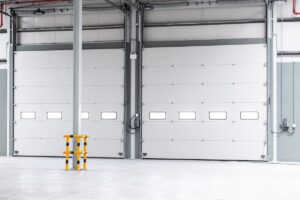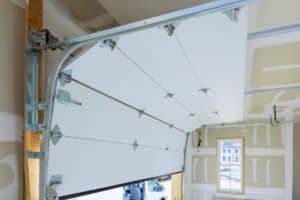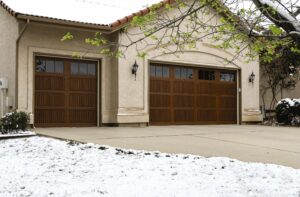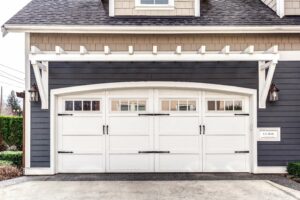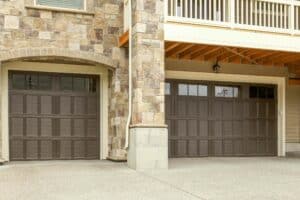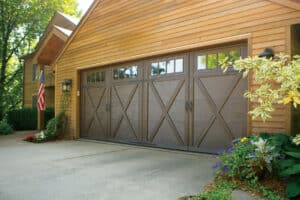Garage door springs are the backbone of your garage door system, allowing it to open and close with ease. While there are various types of springs available, the two most common ones are torsion springs and extension springs. Understanding the differences between these two options is essential for homeowners looking to maintain their garage doors efficiently.
1. Torsion Springs: The Powerhouses of Garage Doors
What Are Torsion Springs?
Torsion springs are typically mounted horizontally above the garage door and placed on a metal shaft. They store mechanical energy by twisting tightly when the door is closed. This unique design allows torsion springs to store energy more efficiently compared to extension springs, resulting in a smoother and more controlled door movement.

The tightly wound coils of a torsion spring are engineered to provide precise counterbalance, ensuring that your garage door can be opened and closed with ease, regardless of its size or weight. This efficient energy storage mechanism not only contributes to the overall longevity of torsion springs but also enhances the safety and reliability of your garage door system.
How Do Torsion Springs Work?
When you activate your garage door opener, it unwinds the tightly wound torsion spring, releasing the stored energy. This energy is transferred to the cables, which then lift the door smoothly. The process is akin to a coiled spring unwinding, gradually and evenly distributing the force needed to raise the garage door. This controlled release of energy not only ensures a stable and balanced door movement but also reduces stress on various components of the garage door system.
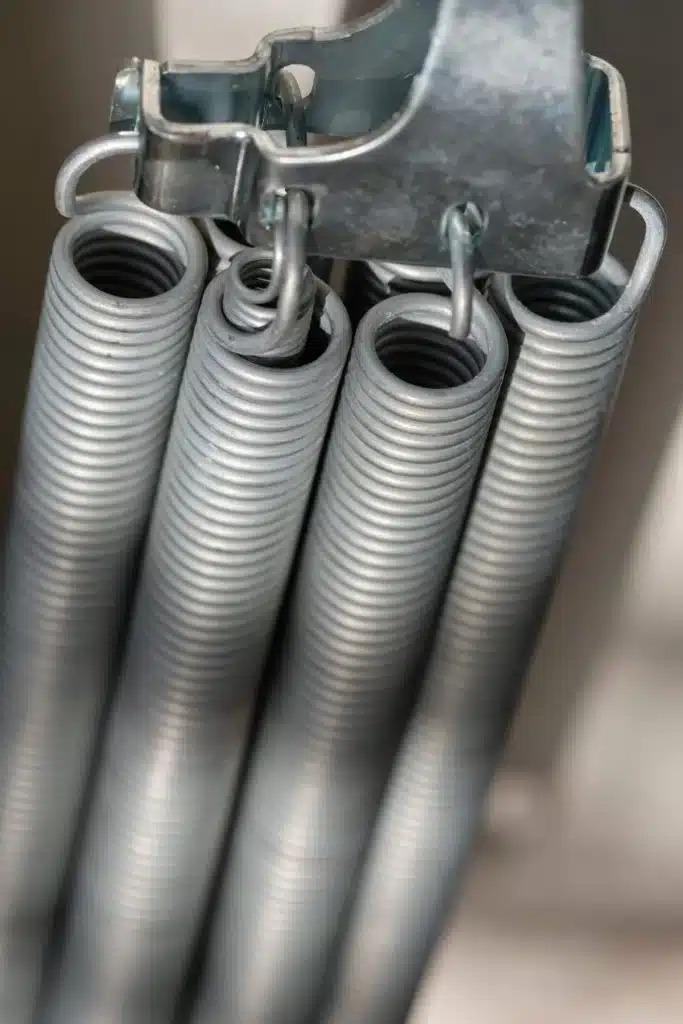
Torsion springs are engineered to provide consistent and reliable performance, making them a preferred choice for many homeowners seeking a hassle-free and durable solution for their garage doors.
Benefits of Torsion Springs
Torsion springs offer a multitude of advantages that make them a popular choice for garage door systems:
- Smoother and Quieter Operation: One of the key benefits of torsion springs is their ability to provide a remarkably smooth and quiet door operation. When you open or close your garage door, you’ll appreciate the absence of jarring movements and loud creaks, creating a more pleasant experience overall.
- Enhanced Durability: Torsion springs are known for their durability and extended lifespan. They are designed to withstand a high number of cycles, which means they can serve you reliably for many years without requiring frequent replacements.
- Improved Safety: Safety is a top priority when it comes to garage door systems. Torsion springs are considered safer due to their installation parallel to the door. This design minimizes the risk of the spring suddenly snapping or causing accidents, ensuring the well-being of you and your family.
Torsion springs not only offer a smoother and quieter operation but also provide long-lasting durability and enhanced safety, making them an excellent choice for homeowners looking for a reliable and secure garage door solution.
2. Extension Springs: A Different Approach
What Are Extension Springs?
Extension springs, in contrast to torsion springs, are typically mounted vertically on either side of the garage door. These springs work by stretching and contracting to provide the necessary force for the operation of the door.
When the garage door is closed, extension springs are in a stretched position, storing potential energy. As you activate the door opener to open the garage, this stored energy is released, causing the springs to contract and assist in lifting the door. Extension springs are known for their simplicity and cost-effectiveness, making them a common choice for residential garage door systems, especially those with limited headroom.
How Do Extension Springs Work?
The operation of extension springs is straightforward yet effective. As the garage door closes, extension springs stretch, and in doing so, they store potential energy. This energy is held within the stretched springs until you initiate the process of opening the garage door. When you activate the door opener, the energy stored in the extension springs is released.
This sudden release of energy propels the springs to contract, which, in turn, assists in the upward movement of the garage door. Essentially, extension springs act as a powerful force that counterbalances the weight of the door, making it easier to lift and lower. This mechanism provides a reliable and cost-effective solution for garage door systems, especially in situations where space constraints limit the use of torsion springs.
Benefits of Extension Springs
Extension springs come with several advantages that make them a suitable choice for certain garage door setups:
- Cost-Effective: One of the primary benefits of extension springs is their cost-effectiveness. They are generally more budget-friendly than torsion springs, making them an appealing option for homeowners on a budget.
- Ideal for Smaller Spaces: Extension springs are particularly well-suited for smaller garage spaces where there may be limited headroom. Their vertical mounting configuration allows them to function efficiently in such settings.
- Balanced Operation: When properly maintained, extension springs provide a balanced operation for your garage door. This means that the door opens and closes smoothly and evenly, reducing the strain on various components and ensuring longevity.
Extension springs offer cost-effective solutions, are suitable for smaller garage spaces, and provide balanced door operation when maintained properly. These benefits make them a practical choice for specific garage door configurations and budget-conscious homeowners.
3. Comparing Torsion and Extension Springs
Lifespan and Durability
When it comes to the lifespan and durability of garage door springs, torsion springs have a distinct advantage over extension springs. Torsion springs are known for their longevity and ability to endure a higher number of cycles of opening and closing. This characteristic makes them a wise long-term investment for your garage door system.
In practical terms, the extended lifespan of torsion springs means fewer replacements and less maintenance, providing homeowners with peace of mind and cost savings over the years. If you’re looking for a durable and reliable option for your garage door, torsion springs are the way to go.
Safety
When it comes to safety, both torsion and extension springs can be safe if properly maintained. However, torsion springs are generally considered safer due to their specific design and placement above the garage door.
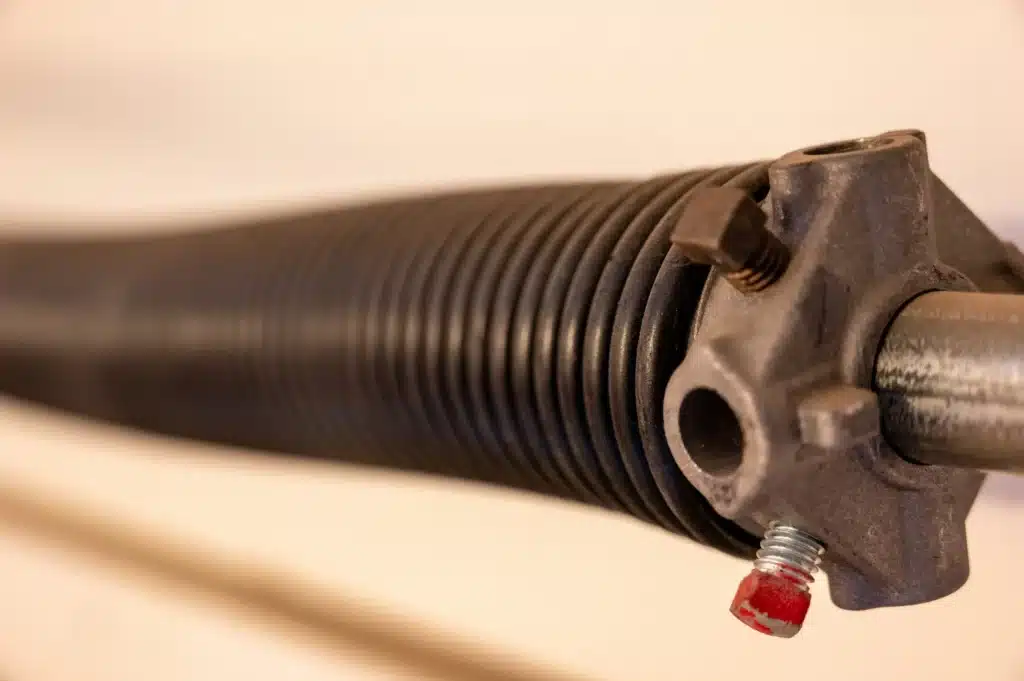
Torsion springs are installed parallel to the door and enclosed in a protective housing, which minimizes the risk of accidents or injuries. This design not only prevents the spring from being exposed but also ensures that in the rare event of a spring breakage, it is less likely to cause harm or property damage.
Extension springs, on the other hand, are mounted vertically on either side of the door, and their exposed configuration may pose a slightly higher risk. While extension springs can also be safe when maintained, the design of torsion springs provides an added layer of safety, making them the preferred choice for homeowners who prioritize safety in their garage door systems.
Cost
When considering the cost factor, extension springs have an initial advantage as they are more budget-friendly upfront. However, it’s essential to look at the bigger picture.
While extension springs may save you money initially, they tend to have a shorter lifespan compared to torsion springs. This shorter lifespan can result in more frequent replacements over time, which can add up in terms of both expenses and inconvenience.
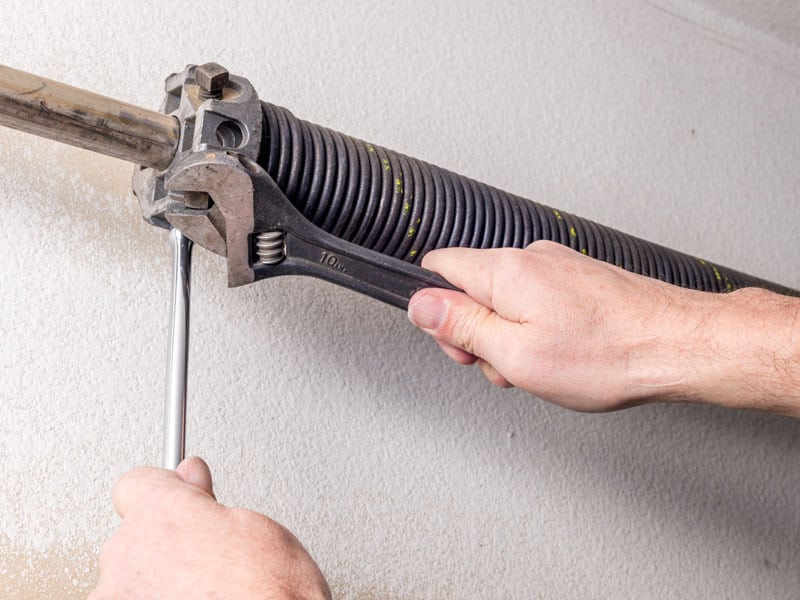
On the other hand, torsion springs, although initially a bit more expensive, offer a more extended lifespan and durability. This means that you are less likely to incur replacement costs and maintenance expenses in the long run. So, while the upfront cost of torsion springs may be higher, they often prove to be a better investment over the years, providing cost savings and peace of mind to homeowners.
4. When Should You Replace Your Garage Door Springs?
Signs of Wear and Tear
Regular maintenance and inspection of your garage door springs are crucial to ensure their proper functioning and safety. Here are some key signs of wear and tear that you should be vigilant about:
- Sagging: If you observe that your garage door appears uneven when in the closed position, with one side lower than the other, it could indicate sagging springs. This imbalance can strain the entire system and lead to further damage if left unaddressed.
- Noisy Operations: Unusual noises, such as squeaking, creaking, or grinding sounds when opening or closing the garage door, can be indicative of worn-out or damaged springs. These noises often result from the increased friction and stress on the springs.
- Slow or Jerky Movements: Springs that are nearing the end of their lifespan may cause the garage door to move slowly or in a jerky manner. This can compromise the door’s smooth operation and even pose safety risks.
- Visible Wear: Examine the springs for any visible signs of wear, such as rust, corrosion, or deformation. Any physical damage to the springs should be taken seriously, as it can weaken their structural integrity.

If you notice any of these signs, it’s essential to address the issue promptly. Delaying the replacement of worn or damaged springs can lead to more significant problems with your garage door system and potentially jeopardize safety. Consulting a professional technician for a thorough inspection and necessary repairs or replacements is advisable to ensure the continued reliable operation of your garage door.
DIY vs. Professional Replacement
When it comes to replacing garage door springs, homeowners often face a choice between a DIY approach and hiring a professional technician. While the DIY option may be tempting to save on costs, it’s essential to consider the safety and efficiency factors involved.
DIY Replacement:
- Cost Savings: DIY spring replacement may appear cost-effective initially as it eliminates service charges.
- Skill and Knowledge: Some homeowners with mechanical skills may feel confident in tackling the task themselves.
Professional Replacement:
- Safety: Garage door spring replacement can be hazardous. The high tension in springs poses a risk of injury or property damage if not handled correctly.
- Experience: Professional technicians have the necessary experience and training to safely and efficiently replace springs.
- Tools and Equipment: Technicians have specialized tools and equipment to perform the job accurately.
- Warranty: Many professional services offer warranties, ensuring that the work is covered if any issues arise afterward.
- Time and Convenience: Hiring a professional saves you time and effort, as they can complete the job quickly and with minimal disruption.

While DIY spring replacement may seem like a cost-saving option, it’s crucial to prioritize safety and efficiency. Due to the potential risks involved, it is generally recommended to hire a professional technician for garage door spring replacement. Their expertise, specialized tools, and commitment to safety ensure that the job is done correctly, providing peace of mind for homeowners.
Conclusion
In conclusion, understanding the differences between torsion and extension springs is vital for maintaining a functional garage door. Torsion springs offer durability and safety, while extension springs are more budget-friendly. Knowing when to replace these springs is crucial for a well-functioning garage door system.
FAQs
Torsion springs are tightly wound coils mounted above the garage door, storing energy to ensure smooth and controlled door movement.
When you activate your garage door opener, torsion springs release stored energy, providing balanced and safe door movement.
Torsion springs offer smoother, quieter operation, enhanced durability, and improved safety for your garage door system.
Extension springs are vertically mounted on either side of the garage door, stretching and contracting to assist in door operation.
Extension springs store energy when the door is closed and release it to aid in lifting the door when opening.
Extension springs are cost-effective, suitable for smaller spaces, and provide balanced door operation.

